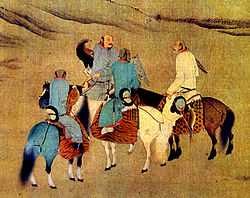Hunting with eagles
Hunting with golden eagles (Aquila chrysaetos) is a traditional art of the Eurasian steppes, particularly defined as "Horse Riding Falconry" or "The Eagle Falconry" in Central Asia. It is a type of falconry.
Terminology
Professional hunters from Kazakhstan call the practice berkutchy or kusbeguy in Kazakh; it is also called berkutchi by the Kyrgyz people of the Bugu clan.[1]
Berkutchy is a life's profession, and in Kazakhstan is often a hereditary one. The relationship of the bird and its master is constant and all-consuming. In the training of a young eagle, the berkutchy must sacrifice his sleep for a long period. For weeks, the growing bird is rendered sightless under its hood until its dependence on its master becomes complete. Such intimacy must turn into a lifelong trust with the eagle - twenty years or more. It is said[citation needed] that as the man trains the eagle, so does the eagle train his man. There is a proverb in Kazakhstan: "There are three things a real man should have: a fast horse, a hound, and a golden eagle.[2]
History

Khitans
In 936-45 AD the Khitans, a nomadic people from Manchuria, conquered part of north China.[3] In 960 AD China was conquered by the Song dynasty.[4] From its beginnings, the Song dynasty was unable to completely control the Khitan who had already assimilated much of Chinese culture. Throughout its 300-year rule of China, the Song had to pay tribute to the Khitan to keep them from conquering additional Song territory.[5] Despite the fact that the Khitans assimilated Chinese culture, they retained many nomadic traditions, including eagle hunting[6] (see the unknown Chinese painting from Song dynasty).
Jurchen
The hai dong qing was an important breed of hunting eagle for Jurchen tribes. The Khitan extorted this kind of eagle from Jurchen but ended in revolt.
Kyrgyz
In 1207, the Kyrgyz nomads surrendered to Genghis Khan's son Jochi. Under Mongol rule, the Kyrgyz preserved their nomadic culture. Archaeologists trace back falconry in Central Asia to the first or second millennium BC.[7] [8]

Kazakhs
Kazakhs (Altaic Kazakhs or Altai-Kazakhs) living in Bayan-Ölgii Province of Mongolia continue to hunt with eagles today. There are an estimated 250 eagle hunters in the Western Mongolian province.[9][10][11] Their falconry custom, so-called 'horse-riding eagle falconry', is unique in practice only with trained Golden Eagle (Aquila chrysaetos daphanea) on horseback. Their hunting target is almost limited to Red Fox (Vulpes vulpes) or Corsac Fox (Vulpes corsac).[12] In the first week of October, 70 eagle hunters gather for the annual Golden Eagle Festival of Mongolia [13] They use eagles to hunt foxes and hare during the cold winter months when it is easier to see the gold colored foxes against the snow.[14]
See also
- Ethnic groups in Chinese history
- Falconry
- Goryeo-Khitan Wars
- Kazakh Steppe
- Kyrgyzstan
- History of Mongolia
- Wolf hunting
External links
- Article on eagle hunting in Kyrgyzstan with pictures
- Altai eagle hunting article
- Golden Eagle Festival
- ‘Contemporary Falconry in Altai-Kazakh in Western Mongolia’The International Journal of Intangible Heritage (vol.7), pp. 103–111. 2012.
- ‘Ethnoarhchaeology of Horse-Riding Falconry’, The Asian Conference on the Social Sciences 2012 - Official Conference Proceedings, pp. 167–182. 2012.
- ‘Intangible Cultural Heritage of Arts and Knowledge for Coexisting with Golden Eagles: Ethnographic Studies in “Horseback Eagle-Hunting” of Altai-Kazakh Falconers’, The International Congress of Humanities and Social Sciences Research, pp. 307–316. 2012.
- ‘Ethnographic Study of Altaic Kazakh Falconers’, Falco: The Newsletter of the Middle East Falcon Research Group 41, pp. 10–14. 2013.
- ‘Ethnoarchaeology of Ancient Falconry in East Asia’, The Asian Conference on Cultural Studies 2013 - Official Conference Proceedings, pp. 81–95. 2013.
Further reading
- Soma, Takuya. ‘The Art of Horse-Riding Falconry by Altai-Kazakh Falconers’. In HERITAGE 2012 (vol.2) - Proceedings of the 3rd International Conference on Heritage and Sustainable Development, edited by Rogério Amoêda, Sérgio Lira, & Cristina Pinheiro, pp. 1499–1506. Porto (Portugal): Green Line Institute for Sustainable Development, 2012.ISBN 978-989-95671-8-4.
- 相馬拓也「アルタイ=カザフ鷹匠による騎馬鷹狩猟: イヌワシと鷹匠の夏季生活誌についての基礎調査」『ヒトと動物の関係学会誌(vol. 32)』: pp. 38–47. 2012.
- Soma, Takuya. ‘Horse-Riding Falconry in Altai-Kazakh Nomadic Society: Anthropological Researches in Summertime Activities of Falconers and Golden Eagle’. Japanese Journal of Human and Animal Relation 32 (2012): pp. 38–47 (written in Japanese).
- 相馬拓也「アルタイ=カザフ鷹匠たちの狩猟誌: モンゴル西部サグサイ村における騎馬鷹狩猟の実践と技法の現在」『ヒトと動物の関係学会誌(vol.35)』: pp. 58–66. 2013.
- Soma, Takuya. ‘Hunting Arts of Eagle Falconers in the Altai-Kazakhs: Contemporary Operations of Horse-Riding Falconry in Sagsai County, Western Mongolia’. Japanese Journal of Human and Animal Relation 35 (2013): pp. 58–66 (written in Japanese).
References
- ↑ The Gyrfalcon by Eugene Potapov and Richard Sale (2005) p. 199
- ↑ Kazakhstan in Pictures (Visual Geography Series) by Bella Waters (2007) p.54
- ↑ The Art of War by Sun Tzu - Special Edition by Sun Tzu and Lionel Giles (2005) p.170
- ↑ China: Its History and Culture (4th Edition) by W. Scott Morton, Charlton M. Lewis, and Charlton Lewis (2004) p.100
- ↑ 5 Steps to a 5: AP World History (5 Steps to a 5) by Peggy Martin (2004) p.115
- ↑ Eagle Dreams: Searching for Legends in Wild Mongolia by Stephen J. Bodio (2003) p. 26
- ↑ http://www.firstscience.com/home/articles/origins/ancient-falconry_1381.html
- ↑ http://iafor.org/offprints/acss2012-offprints/ACSS2012_offprint_0271.pdf
- ↑ http://www.ijih.org/volumeMgr.ijih?cmd=volumeView&volNo=7&manuType=02
- ↑ http://www.analytrics.org/Documents/HSS_Actes_Proceedings_2012.pdf
- ↑ http://www.mefrg.org/images/falco/falco41.pdf
- ↑ http://matadornetwork.com/trips/photo-essay-hanging-with-eaglehunters-in-western-mongolia
- ↑ http://www.mongoliatourism.gov.mn/newsView/113
- ↑ http://discover-bayanolgii.com/